
 This article has been an unusually difficult one to write because the subject matter is ubiquitous, difficult to think in single unit terms due to its interconnectedness, and has such a long realization timetable that it becomes part of a daily ritual rather than event.
This article has been an unusually difficult one to write because the subject matter is ubiquitous, difficult to think in single unit terms due to its interconnectedness, and has such a long realization timetable that it becomes part of a daily ritual rather than event.
Who hasn’t felt the impact and associated disruption that bridge, rail androad construction entails? When the infrastructure is finally completed, it is such a total transference to the ‘new’ that any attempt to remember what existed before conjures up a cloudy image.
It is these attributes of infrastructure that allow the authors to quickly draw the first conclusion of this article – for the vast majority of the general population, infrastructure exists in the present. Only for a small group of professionals, a subset of government officials and businesses in need of access to infrastructure is a future tense meaningful.
Thus it is easy to understand why infrastructure is not inherently exciting to discuss or is typically referenced as a causal link to economic development. It is also why the risk of media backlash is very real when infrastructure is touted as a vehicle for economic development. Some discussion about the media risks will follow later in the article, but for the moment it is important to establish a point of reference.
Infrastructure – Back Then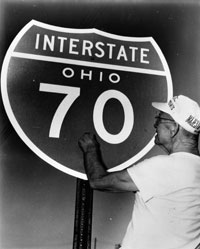 The United States government’s investment in infrastructure has a long history of assisting in the foundation of communities by providing interconnectivity between residents, industry and limitless opportunities.
The United States government’s investment in infrastructure has a long history of assisting in the foundation of communities by providing interconnectivity between residents, industry and limitless opportunities.
Canals, roads and railroads investments began early in New England and along the East coast and then moved westward as frontiers opened up, commerce developed and statehood was achieved. Canals in the 1800s were ideally suited to the movement of large volume agricultural commodities, but building a canal required substantial investments by government using development bonds.
At the time, floating bonds seemed logical given the agrarian economy. By the mid 1830s it was apparent however, that with the exception of the Erie and Champlain canals, most canal ventures had failed and individual states were left with the debt, often with disastrous effects.
The emergence of private ventures in infrastructure, partially backed by public bonds and grants, particularly in the case of the railroad lines, grew out of the need to further the infrastructure development under conditions of lower financial risk to government. But government’s involvement in the decisions of where to put what kind of infrastructure invariably generated quite a bit of debate.
In the late 1840s for example, there was a major convention of 5,000 delegates in Chicago (then populated by 16,000 people) between the Whig and Democrat parties as to whether the “internal improvements bill” sponsored by the Whig party should become law in light of President Polk’s opposition to it. Much later during the New Deal era of the 1930s, an unprecedented $3.0 billion was invested by government in infrastructure to stimulate the economy during a time when the unemployment rate reached 25 percent.
Infrastructure - Today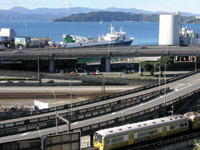 Today, infrastructure permeates every aspect of one’s daily life and while it appears to be in a mature state of development in this country, it is not necessarily in good repair.
Today, infrastructure permeates every aspect of one’s daily life and while it appears to be in a mature state of development in this country, it is not necessarily in good repair.
According to an annual study conducted by the American Society of Civil Engineers (ASCE) on the state of America’s infrastructure, ASCE has concluded that the U.S. infrastructure is in serious need of attention. Part of the study involved grading the state of the infrastructure on an A-F scale. America’s Infrastructure received a D average for 2009, with no category receiving higher than a C+ (http://www.infrastructurereportcard.org/ ).
ASCE has estimated that a five year investment totaling $2.2 trillion is needed to put the nation’s infrastructure in a state of good repair. So the American Recovery and Reinvestment Act(ARRA) passed in early 2009 devoting a total of $80.9 billion to infrastructure – a good idea and one that could create jobs. The infrastructure link to economic development seemed straightforward but the concept’s implementation has been slow going.
A look at the federal government’s website which tracks ARRA performance (www.revovery.gov) provides some insight. According to the Department of Transportation’s (DOT) agency data, $2.88 billion has been paid out of the $28.5 billion available as of September 11, 2009.
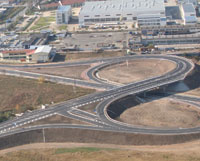 When the Department of Homeland Security and Department of Housing and Urban Development agency sites are reviewed, a similar threshold (approximately 10 percent) of funds paid out is observed. It should be noted that contracts with entities that provide the necessary skill and tools to complete a project are executed months in advance of the actual funds flowing because ‘grants’ awarded by government are based on a reimbursement model instead of upfront cash flow. Factoring in the cash flow lag period helps to explain the relatively low pay out but the picture is incomplete.
When the Department of Homeland Security and Department of Housing and Urban Development agency sites are reviewed, a similar threshold (approximately 10 percent) of funds paid out is observed. It should be noted that contracts with entities that provide the necessary skill and tools to complete a project are executed months in advance of the actual funds flowing because ‘grants’ awarded by government are based on a reimbursement model instead of upfront cash flow. Factoring in the cash flow lag period helps to explain the relatively low pay out but the picture is incomplete.
While the ARRA bill was being negotiated in Congress, each state put together a list of “shovel ready” projects and identified specific programs that required additional funding. Armed with their respective needs list, the process of negotiation began. The reader of this article may recall that some states elected to not accept, or hesitated to accept, an allocation because performance requirements and potential claw backs were stipulated in the agreements between the Federal government and the respective states. Each state had to assess the near- and medium-term benefits against the long-term risks of failing to meet goal deadlines, or inability to provide sustained funding. Once agreement was achieved, the internal machinery responsible for contracts between state and local governments began to churn. It is likely that months passed during this time with the end result being the establishment of accounts from which project specific reimbursements could be made. So August or September of 2009 really was the earliest that infrastructure funds would begin to flow.
Can government (federal, state and local), working in concert with the private sector, deliver the agreed upon projects within the 24 month ARRA goal timeframe? Yes, if capacity for performance is assigned a higher priority than equitable participation on the local level. Out of necessity, a community’s economic status will only be one factor in an infrastructure grant award, so some areas will experience little to no activity. The hope is that the sheer magnitude of all statewide infrastructure projects will help drive economic development (and jobs)to areas in need.
This is not the first time that government has used infrastructure to generate jobs, as was noted earlier in the article. Can a sustained recovery be achieved using infrastructure as the stimulus? Yes, if given enough time. The following case studies will help to clarify some of the issues.
Case Study 1
A manufacturing company located in a rural county in a southern state needed access to rail for inbound raw materials and outbound products in order to cut transportation costs. The nearest access point to a major rail line was less than a half mile away. The need for the rail spur became more urgent as fuel prices climbed in 2007/08 and the economic downturn’s impact on the company’s revenues was felt.
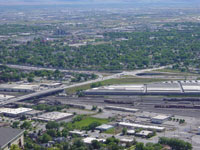 Consideration was even given to a relocation of the operation in the event that a rail spur could not be built. Several funding sources, including ARRA stimulus funding from different levels of government, were ultimately secured for a combined contribution of $1.5 million to cover all but an expected $75,000 (company cash contribution).
Consideration was even given to a relocation of the operation in the event that a rail spur could not be built. Several funding sources, including ARRA stimulus funding from different levels of government, were ultimately secured for a combined contribution of $1.5 million to cover all but an expected $75,000 (company cash contribution).
In exchange for the infrastructure assistance, the company agreed to remain at the site, to invest several million dollars, to use and maintain the rail spur, to retain a baseline headcount and to create fulltime jobs.
The requests for funding and various negotiated agreements took about 16 months to complete. Land acquisition, site preparation and rail construction is currently on track to be completed within four months.
The actual construction timetable is too short for the construction-related jobs to have any real sustained impact. The community will feel the benefit of property taxes associated with this project earlier than expected, and the retention of jobs will help to prevent a further deterioration of employment locally, but the creation of net new permanent fulltime jobs will lag until demand for product increases.
In this instance, the infrastructure project has served as a near-term economic sustainable tool rather than an economic development tool – a necessary activity but not enough for a recovery.
Case Study 2 The second case study is one on a much larger scale, is currently competing for stimulus funding and is in an area that desperately needs jobs to be created (the September area unemployment rate >16 percent).
The second case study is one on a much larger scale, is currently competing for stimulus funding and is in an area that desperately needs jobs to be created (the September area unemployment rate >16 percent).
The total projected investment in the multi-modal site is expected to exceed $150 million, of which nearly half will be infrastructure related costs. No single source from government is likely to contribute the $75 million required to complete the entire infrastructure. If government can cobble together the funding however, there will be a real immediate jobs benefit to the community.
Unlike the preceding example, the timeline for site preparation and construction will take place over a 24 month period, will create 713 direct construction jobs and will result in an additional 1,600 indirect jobs.
Infrastructure as an Economic Development Tool
Scale and time are two significant factors which have to be addressed if infrastructure is to be used as an economic development tool during the current recession. This being said, smaller infrastructure projects like the example provided in the first case study, play a local role in economic development but cannot produce a regional recovery.
Scale is also an issue from the grants management perspective. The ARRA stimulus funding is being processed through existing channels of government. It has to be given the time constraints imposed by ARRA. A multitude of small projects would be a less efficient use of government personnel than large scale projects because of the negotiation, monitoring and compliance obligations required in each project. Larger infrastructure projects, plus big dollar investments, equals more media attention. Nothing spurs a media report along faster than the belief that public funding has been abused.
Does all this mean that the smaller projects should be avoided during times of economic hardship? The temptation to assemble a pool of funds in the hope that a large regional project will be forthcoming is unrealistic. Government cannot afford to ignore any company’s reasonable request for infrastructure if the company is willing to contractually obligate a significant capital investment, the retention of good paying jobs and the creation of new permanent positions. It is also important that a company understand these are the times to negotiate from the perspective of a conservative scenario.
Public Awareness of Infrastructure Projects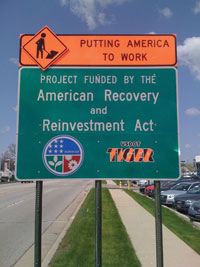 This leads us to the second conclusion of this article, which is the general public is now more aware of infrastructure projects. Why? The public has been told that the funding provided by ARRA, which includes dollars allocated for infrastructure, will stimulate a recovery of the economy. A recovery under the current circumstances is synonymous with jobs being created.
This leads us to the second conclusion of this article, which is the general public is now more aware of infrastructure projects. Why? The public has been told that the funding provided by ARRA, which includes dollars allocated for infrastructure, will stimulate a recovery of the economy. A recovery under the current circumstances is synonymous with jobs being created.
If external factors delay or prevent a timely infrastructure project completion, or if too few or too narrowly defined employment opportunities are created, then the media will question the decision making capabilities of those who sponsored the legislation. If the item remains a focus long enough, it will become a political campaign issue. There is ample historical evidence to support this last statement. So the media risk associated with ARRA infrastructure projects is not to be ignored. The more government can do to set realistic expectations, the better the outcome for all stakeholders.

